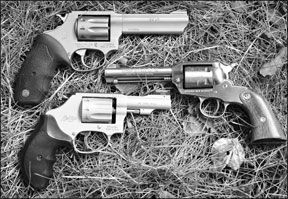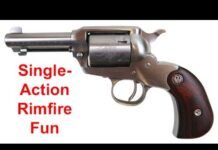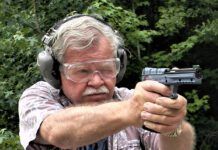In our ongoing search for the best .22 handgun for the trail, wherever that trail may take us, weve looked at a bunch of .22 handguns and have rejected quite a few. This time we mix the single-action stainless Bearcat from Ruger ($480) with a DA Model 94SS4 from Taurus ($406), and take a look back at one of our earlier test guns from March 2006, the eight-shot S&W AirLite Model 317 ($735) with “HIVIZ” sights.
Below, we recap the earlier results from the AirLite first, add long-term results weve gleaned about it since our original test, and then mix in facts and opinions about the other two guns to produce grades for the Ruger and Taurus guns.

Smith & Wesson
Model 317 AirLite, $735
In March 2006 we shot this gun against a shorter-barrel S&W and against the neat, accurate, Taurus Ultra-Lite Nine. In that company the Smith rated a Conditional Buy. The big draw of this gun is its light weight. The big drawback is its hefty price tag. We didnt much like its sights back then, and we still dont. We did some additional shooting for this test series, the gun having been purchased by one of our staff and thus still available to us. Time did little for the sights (we could not get normal sights for it from S&W, though we tried hard), and that means the accuracy was still not all that solid. But it essentially shot as well as the other two guns here. In a nutshell, the S&W AirLite has metal removed wherever possible. The frame, cylinder, and barrel housing are made of aluminum. The barrel itself is a steel insert. The resulting extremely light gun holds eight shots and weighs 12.5 ounces.
It has fully adjustable sights with a V-notch rear and a “day-glo” green front insert that catches whatever light is available. Sometimes this is useful. Often it is not. We can, in fact, see the front sight very well against a variety of backgrounds. These sights dont-cant-give the finest target-like accuracy because of the lack of a clearly defined flat top to the front blade. But for fast shooting, which might be called for on the trail, this setup has a lot going for it.
This very light little revolver would most likely be our first pick of this trio for field usage, despite its odd sights. It weighs about one-half of either of the other two. It had the best trigger, which broke exceptionally cleanly at 3.0 pounds. Yet it had the worst sights, which gave no exact idea where the gun was aiming, for precise shooting. The rounded, glowing green front bead nestled into the V-shaped rear, but the top of the picture was not easy to define because of the round bead. A custom-made front blade with a flat top could still incorporate this green bead. The grip was comfortable, and the cylinder had the best lockup of the trio. Yet the AirLites list price was close to double that of the other two. Street prices would help, but youll still pay a premium for this one.
Taurus Model 94SS4
.22 LR, $406
If you recall, we tested a Taurus Model 941 .22 Magnum revolver in July 2007, but the gun failed to fire. We thought that if it had worked, it might rate a C, but we didnt like the high cost of the ammo it used. However, we were plenty interested in a .22 LR version of that gun, so we got one, and it goes bang every time. The Taurus 94 is a good-looking, nicely finished, matte-stainless, nine-shot revolver with good adjustable sights and a mighty comfortable grip. Workmanship appeared to be excellent. One thing we didnt like was the fact that the hammer is difficult to cock. The DA pull was perhaps useful, if heavy, but the hammer was short, sharply checkered, and had one heck of a hill to climb as the thumb pulled it back. The hammer incorporated Tauruss clever lockout system, which some will find useful. The trigger broke cleanly at 5 pounds, but it felt like a lot less. Some lock work might give a lighter trigger and reduce the force needed to cock the hammer, though it was certainly functional as we found it.
Looking deeper into the gun we found the ejector rod lifted the empties only half an inch. While wed like a longer throw (the S&W had 50-percent more travel), if you have fired only a few of the nine cartridges, this limited travel would lift the empties partially, retain the unfired rounds, and the empties could then be withdrawn with ease. And if you want to zing em all, a swift tap with the ejecting finger gets them all flying. With the cylinder swung open, we noted the bolt had lots of play side to side. This didnt bode well for the guns accuracy, which ultimately depends on a tight lockup. There was in fact noticeable movement to the cylinder with the gun in the just-fired configuration. But the proof is in the putting, so it was time to take it to the range and put it to the test.
Our official test ammunition this time was Winchester Super-X HP, CCI Stingers, CCI Small Game Bullet loads, and Federal Gold Medal Match. In addition, we fired the guns with a variety of other ammunition including some used in the previous test of the S&W 3-inch gun. The Taurus got its best accuracy with Federal Gold Medal Match, but the Super-X load wasnt far behind. We noticed the gun had a tendency to put four into one group and another elsewhere. There was also some spitting with some of the loads, and these are possible indications of a less-than-perfect lockup.
Ruger Stainless
New Bearcat, $480
This was an attractive little revolver. It was simple yet functional. It lacked adjustable sights, and the overall appearance smacked of the Old West. Surely any cowboy worth his Stetson would like the looks and feel, we thought. But be advised, this is a small handgun. Theres not a lot of room for the trigger finger inside the trigger guard. The grip was small but adequate for control, and we liked the rosewood grip panels. The cylinder had roll engravings of a cougar and a bear, true to the bear-cat moniker. As with most Ruger firearms, workmanship was excellent throughout.
The ejector-rod housing was of aluminum. The remainder of the little gun was of stainless steel, nicely fitted, machined, and finished. The rounded front-sight blade was flat on top and the rear notch in the frame was square, and after we blacked the front blade we had as good a sight picture as anyone would want. The gun is loaded and unloaded just like the SA Colt of old. Put it on the first cocking notch, swing open the loading gate, poke out the fired rounds one at a time, and slide in the new. You can safely load six, because of the transfer-bar design of the gun. The gun had one slightly annoying feature for some of us, despite the excellent workmanship and good design feature involved. The cylinder had a rear lip that effectively hid the loaded rounds from sight and kept dirt out of the star, but this design doesnt let you see which one is the empty chamber, if you load only five.
The Bearcats hammer was wide, with good serrations for easy cocking. The trigger pull was clean but stiff, at about 4.8 pounds. We found loading and unloading the Bearcat was not as easy as charging the other two guns with their swing-out-cylinders. The .22 LR cartridges and the Bearcat were too small to make loading and unloading as easy as with a .45 Colt SA. Yet it worked, and the setup was very simple and sturdy. We were not able to get brilliant accuracy during our limited testing, despite the good lockup and decent sights. Our best average was with CCIs Small Game Bullet loads, giving about 1.6-inch five-shot groups at 15 yards. That may be enough.
ACCURACY_CHRONO_PLINKERS_1007.pdf



























